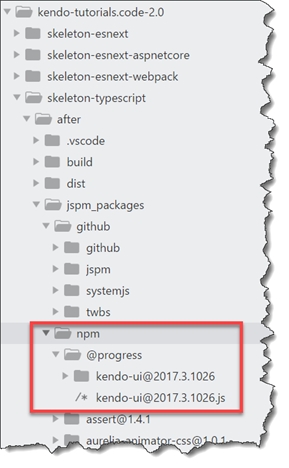typescript - kendo
Application Developer tutorials
typescript kendo
Summary
Details on building and running this applications are here.
Kendo Core and KendoUI bridge installation is defined in this section of the Installation document.
Details
The subsequent steps are applied to the copy of the original typescript sample, which is located in the "after" folder, rebuilt and verified from scratch using the command
npm install && jspm install && gulp watchStep 1.
Run the following command in the console (note the format npm:@progress/kendo-ui):
jspm install css npm:@progress/kendo-ui aurelia-kendoui-bridge
Image 1 - installed KendoUI SDK using npm
Step 2.
Update config.js by adding the last line, pointed by the arrow.
Step 3.
Run the following command in the console:
Note: since Typescript 2.0, the command below is deprecated, although it may still work. Do not run this, if npm install @types/kendo-ui is sufficient to make your application run correctly
Step 4.
Add this *autocomplete.ts file to the project
Step 5.
Add this autocomplete.html file to the project
Step 6.
Add this autocomplete.css file to the project
Step 7.
Add the request to load the aurelia-kendoui-bridge plugin by adding the statement .plugin('aurelia-kendoui-bridge'; to the file main.ts
Step 8.
Add the following line to app.js
Important note
You can find this complete application as a companion document to this book. The application's README file covers some sections in even more details, so make sure to check this document.
Last updated